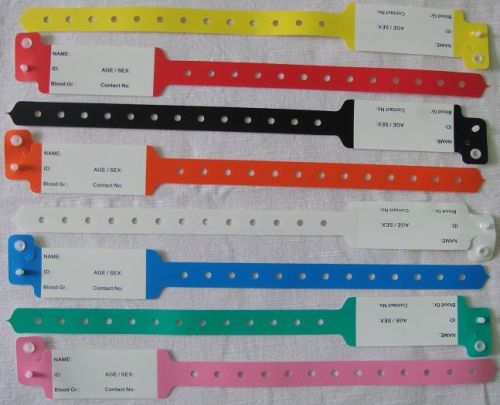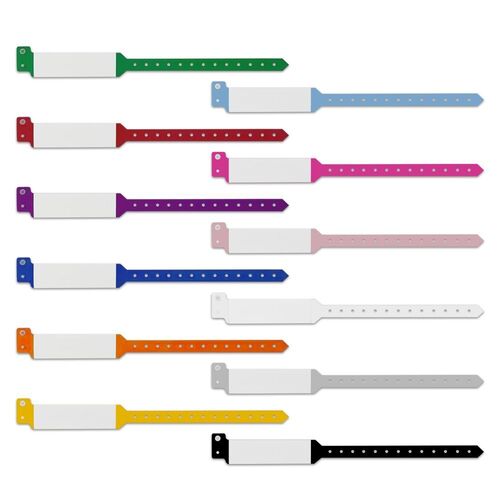Exploring the Different Kinds Of Patient Identification Band Made Use Of in Clinical Facilities
In the complex globe of health care, the important function of Patient Identification bands frequently goes unnoticed. These bands, varying from simple paper wristbands to innovative RFID bands, create the backbone of Patient safety methods, guaranteeing accuracy in Patient Identification. The substantial diversity of these bands, each with its unique benefits and constraints, is typically ignored. As we navigate with this subject, one may obtain understanding into the subtle complexities and crucial relevance of such bands in medical facilities.
Recognizing the Significance of Patient Identification Bands
While they might appear like plain accessories, Patient Identification bands play a crucial duty in clinical centers. These bands work as a critical tool for validating Patient identification, protecting against clinical mistakes associated to misidentification. The bands typically display vital info such as the Patient's name, age, blood type, and any recognized allergies. They permit medical care professionals to quickly access this essential info, therefore promoting accurate and prompt medical treatment. Patient Identification bands additionally help in streamlining management tasks, making sure precise record-keeping and payment. Despite their simplicity, these bands symbolize the concept of Patient safety and security, a foundation of top quality healthcare. Without them, the risk of medical mistakes, and consequently, Patient injury, might substantially raise.
Traditional Paper Wristbands: Their Use and Limitations
Standard paper wristbands have been a staple in Patient Identification across different clinical centers. While their use prevails, they harbor specific restrictions that might influence their performance in Patient management. This area will certainly concentrate on the range of their application and the intrinsic drawbacks related to their use.
Paper Wristbands: Usage Scope
In the world of Patient Identification, paper wristbands have actually long held a crucial duty. These bands are typically utilized in outpatient setups, where the Patient's keep is momentary. Despite innovations in innovation, the modest paper wristband remains a reputable and economical service for Patient Identification in different healthcare situations.
Limitations of Paper Wristbands
Regardless of their extensive usage, paper wristbands are not without their drawbacks. In addition, paper wristbands commonly lack the technical capacities of more modern options, such as barcoding or RFID chips, restricting their capability to just presenting created information. Paper wristbands can trigger discomfort or skin irritation to some individuals, particularly when used for extensive durations.
Barcoded Wristbands: Developments in Patient Identification
While Patient Identification has long been an essential facet of health care, the introduction of barcoded wristbands signifies a considerable jump forward. These bands utilize the simplicity of barcoding innovation, permitting for Patient information to be quickly checked and accessed. They enhance the speed and precision of Patient Identification, lowering the danger of clinical mistakes associated with misidentification. Barcoded wristbands are cost-effective, very easy to generate, and remove handwriting mistakes common with hand-operated systems. They are not without limitations. While they use improvements over standard bands, the barcode can end up being smudged or worn, rendering it unreadable. In spite of this, barcoded wristbands remain a crucial tool in modern healthcare setups, signifying the intersection of technology and Patient care.
Radio Frequency Identification (RFID) Bands: an Action In The Direction Of Futuristic Healthcare
The advancement of Patient Identification bands has actually brought about the development of Superhigh frequency Identification (RFID) Bands (patient identification band). These ingenious gadgets present key advantages for healthcare centers, offering a much more efficient and highly advanced methods of Patient Identification. The implementation of RFID in healthcare is a considerable action in the direction of a much more advanced method to Patient administration and safety
Understanding RFID Bands

RFID Bands: Key Advantages
Accepting a future where technology and medical care combine, radio frequency Identification bands provide several essential advantages. Mainly, these bands improve Patient security by offering exact, instant Identification, consequently reducing clinical mistakes. RFID bands can keep a vast amount of Patient information, including clinical history and allergic reactions, enabling customized treatment. They also improve administrative tasks, as the automated information access changes hands-on processes, improving efficiency and reducing paperwork. RFID bands use real-time tracking of patients, critical in high-risk environments such as surgical procedure or extensive treatment. These bands are immune and durable to ecological variables, ensuring regular capability. On the whole, RFID bands stand for a substantial innovation in Patient Identification innovation, profiting both individuals and health care suppliers.
Implementing RFID in Medical Care
As we enter a highly advanced era, the implementation of RFID bands in healthcare becomes significantly important. These bands give a smooth means to track and recognize individuals, guaranteeing their safety and security and improving effectiveness in treatment procedures. RFID bands supply countless benefits over standard Identification methods. They can store a vast quantity of data, consisting of the Patient's clinical history and More Bonuses treatment plans, which can be conveniently accessed by doctor. This information aids physicians make educated choices pertaining to the Patient's therapy strategy. In addition, RFID bands decrease clinical errors by giving exact Patient Identification, which is crucial in avoiding misdiagnosis or incorrect medication management. Thus, the application of RFID bands is special info a substantial action towards enhancing Patient security and medical care delivery.

Color-Coded Wristbands: Assisting in Quick and Accurate Diagnosis
In the bustling environment of a clinical center, color-coded wristbands have actually arised as important devices for swift and exact Identification of a person's medical problem. These wristbands, worn by clients, lug particular colors that match to different medical conditions or conditions. This system is made to supply immediate aesthetic hints to healthcare suppliers, improving Patient security and care top quality.
Approaches for Reliable Execution and Management of Patient ID Bands
Attaining ideal use of Patient Identification bands necessitates a well-structured approach for their execution and administration. The initial step involves training all health workers on the value of appropriately applying and checking out these bands. Medical facilities need to standardize the usage of ID bands throughout all divisions, ensuring uniformity and reducing discrepancies. Normal audits must be carried out to verify adherence to plans and to correct any variances. Patient education and learning is likewise vital; individuals have to recognize the purpose of the bands and the need for their continuous wear. patient identification band. It's essential to have a back-up plan in area, such as barcode scanning or biometrics, to guarantee that Patient Identification is never jeopardized.
Conclusion
Patient Identification bands are vital in medical facilities to ensure safety and security and accuracy. Reliable implementation and monitoring of these bands can considerably lower medical errors, boost effectiveness, and boost general Patient care.
These bands, varying from simple paper wristbands to advanced RFID bands, develop the foundation of Patient security methods, guaranteeing precision in Patient Identification.The evolution of Patient Identification bands has brought concerning the emergence of Radio Regularity Identification (RFID) Bands. Overall, RFID bands represent a considerable development in Patient Identification innovation, benefiting both individuals and medical care carriers.
RFID bands reduce medical errors by supplying precise Patient Identification, which is vital in avoiding misdiagnosis or wrong medication administration. Patient education and learning is also important; clients have to comprehend the function of the bands and the requirement for their consistent wear.